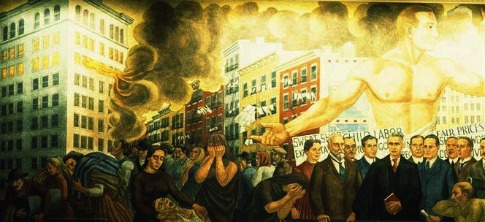The Triangle Shirtwaist Factory Fire: From 1911 to 2024

[History of the Needlecraft Industry, 1938, by Ernest Fiene (Detail)]
March 25, 2024 - The Triangle Shirtwaist Factory Fire, that terrible man-made tragedy that took place in New York City a bit over a century ago, is being memorialized in programs across the country. And that is why we commemorate it on March 25th this year, at the site of the fire, on the corner of Washington and Greene Streets, just east of Manhattan's Washington Square Park. On March 25, 1911, 146 garment workers, mostly young, mostly women, mostly Jewish and Italian immigrants and children of immigrants, died as a result of this calamity, either by being burned or as a result of jumping to their deaths. Most of the workers could not escape because managers locked the doors to the stairwells and exits to keep them from leaving early. The fire trucks' ladders of that day could only reach the sixth floor - those who perished were on the eighth, ninth and tenth floors.
Occurring in the midst of five years of labor organizing in the clothing industry in a number of cities across the United States, the fire shocked the city, the country and the world. Legislation requiring improved factory safety standards was passed in the immediate aftermath of the fire. The International Ladies' Garment Workers' Union, the Amalgamated Clothing Workers of America, and other unions had been fighting for better and safer working conditions for working men and women in all workplaces. And today’s unions are still fighting.
Many of our grandparents and great-grandparents played a critical role in building a strong and vibrant labor movement, with the hope that it would endure and remain a permanent feature of American life. Through their actions and their struggle, our lives and the lives of many Americans were made better. Today, alas, those hard-fought gains are still under threat in communities across the United States.
The history of the American Jewish community is seen as one of upward mobility and expanding economic opportunity. But upward mobility and shared prosperity cannot be achieved by lowering job standards and pitting workers against each other - which is what some would like to do. The divisions that are part of the attack against organized labor must be challenged - by unions and their community allies as well.
Many Jewish texts, from the Torah through the Talmud, deal specifically with the treatment of workers. The Torah urges “justice, justice, shall you pursue.” There is, then, a deeply moral, historical and theological basis for our efforts to defend basic workers’ rights, to close the widening gap between the rich and poor, and to prevent growing economic instability that will be detrimental for all who live and work in the United States of America. This demands that we strengthen, not weaken, private and public sector unions to ensure that current and aspiring middle class Americans attain a decent standard of living and greater economic security.
Durable coalitions that include organized labor and the organized Jewish community need to support policies that will boost overall working conditions and lift up workers who are the least well-off. We know from our own experience that the middle class was built not by making jobs worse but making jobs better: unions fought hard to raise standards across industries and occupations, and we were all better off for it.
Remembering what Jews did over a century ago, and continue to do today, as working people and for a strong American economy should inspire us today to continue the struggle for a society that promotes workers’ rights and safety, justice, and ensures equality and fairness for all.
The Jewish Labor Committee is proud of our work to bring the Jewish community and the labor movement together in common cause - and we invite you to join us. If not now, when?
It took that terrible fire a century ago to shock many into finally accepting the need for reform, and to defend the interests of workers. Solidarity with garment workers, and among workers of diverse kinds, became a daily bond that fortified our own communities. We must remember this today as we remember those who perished in the Triangle Shirtwaist Factory Fire 113 years ago, and think of all working people whose basic rights are under attack.